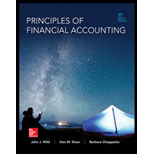
Concept explainers
1.
Compute the break-even point in dollar sales for each product.
1.
Explanation of Solution
Break-Even Point: It is the point of sales at which entity neither earns a profit nor suffers a loss. It can also be said that the point of sales at which sales value of the entity recovers the entire cost of fixed and variable nature is called break-even point
For Product BB:
Given, 50,000 units sold for $800,000, variable costs incurred is $560,000, and fixed costs are $100,000. Contribution margin ratio is 30% (Working note 1).
Compute the break-even point in dollar sales for year:
Therefore, break-even sales for Product BB for the year are $333,334.
Working note1: Compute the contribution margin ratio
| Sales price per unit | $16 |
| Variable costs per unit | $11.20 |
| Contribution margin per unit (B) | $4.80 |
| Contribution margin ratio | 30% |
Table (1)
For Product TT:
Given, 50,000 units sold for $800,000, variable costs incurred is $100,000, and fixed costs are $560,000. Contribution margin ratio is 87.5% (Working note 2).
Compute the break-even point in dollar sales for year:
Working note 2: Compute the contribution margin ratio
| Sales price per unit | $16 |
| Variable costs per unit | $2 |
| Contribution margin per unit (B) | $14 |
| Contribution margin ratio | 87.5% |
Table (1)
Therefore, break-even sales for Product TT for the year are $640,000.
2.
Prepare the contribution margin income statement.
2.
Explanation of Solution
Contribution margin income statement: It is a kind of income statement which reports the sales, variable costs, contribution margin, fixed costs, and net profit.
Sales are declined to 33,000 units. Therefore revised sales for Product BB are $528,000
Prepare the contribution margin income statement:
| Company S | ||
| Product BB | Product TT | |
| Sales | $528,000 | $ 528,000 |
| Less: Variable costs | 369,600 | 66,000 |
| Contribution margin | 158,400 | 462,000 |
| Less: Fixed costs | 100,000 | 560,000 |
| Income before taxes | 58,400 | (98,000) |
| Less: Income taxes (32%) | 18,688 | (31,360) |
| Net income | $39,712 | $(66,640) |
Table (2)
Therefore, net income for Product BB is $39,712 and net loss for Production TT are $66,640.
3.
Prepare the contribution margin income statement.
3.
Explanation of Solution
Contribution margin income statement: It is a kind of income statement which reports the sales, variable costs, contribution margin, fixed costs, and net profit.
Sales are increased to 64,000 units. Therefore revised sales for Product BB are $1,024,000
Prepare the contribution margin income statement:
| Company H | ||
| Forecasted Contribution Margin Income Statement | ||
| Product BB | Product TT | |
| Sales | $1,024,000 | $1,024,000 |
| Less: Variable costs | 716,800 | 128,000 |
| Contribution margin | 307,200 | 896,000 |
| Less: Fixed costs | 100,000 | 560,000 |
| Income before taxes | 207,200 | 336,000 |
| Less: Income taxes (32%) | 66,304 | 107,520 |
| Net income | $140,896 | $228,480 |
Table (3)
Therefore, net income for Product BB is $140,896 and for Production TT is $228,480.
4.
Identify the Product that would experience a greater increase in income when the sales are increase greatly. Explain the same.
4.
Explanation of Solution
Product TT will experience a greater Increase in the income when the sales are increased greatly. The operating leverage of these two products would yield the same implication. Precisely, higher operating leverage reveals higher fixed costs, which indicates greater influences on income from changes in sales levels.
5.
Describe some factors that might have created the different cost structures for these two products.
5.
Explanation of Solution
Factors that could cause Product BB to have lower fixed costs might include:
- The labours are paid based on the units produced.
- Sales representatives work only on the basis sales commission.
- Managers are remunerated with a share of profits instead of salaries.
- Assets that are used in production of Product BB are taken on lease with the rent based on asset usage.
In contrast, fixed costs for Product TT may be higher because of:
- A salary structure that is not based on production or sales.
- Product TT's assets that are owned or acquired under a lease agreement based on time, and not on asset usage.
Want to see more full solutions like this?
Chapter 21 Solutions
Principles of Financial Accounting.
- Please show me how to solve this financial accounting problem using valid calculation techniques.arrow_forwardCould you help me solve this financial accounting question using appropriate calculation techniques?arrow_forwardCan you explain this general accounting question using accurate calculation methods?arrow_forward
- how much overhead cost would be assigned to product G98X using the activity based costing system ?arrow_forwardThe closing price of a stock is $74.55, and the net earnings per share are $3.50. The stock's P/E ratio is .arrow_forwardI need guidance with this general accounting problem using the right accounting principles.arrow_forward

 AccountingAccountingISBN:9781337272094Author:WARREN, Carl S., Reeve, James M., Duchac, Jonathan E.Publisher:Cengage Learning,
AccountingAccountingISBN:9781337272094Author:WARREN, Carl S., Reeve, James M., Duchac, Jonathan E.Publisher:Cengage Learning, Accounting Information SystemsAccountingISBN:9781337619202Author:Hall, James A.Publisher:Cengage Learning,
Accounting Information SystemsAccountingISBN:9781337619202Author:Hall, James A.Publisher:Cengage Learning, Horngren's Cost Accounting: A Managerial Emphasis...AccountingISBN:9780134475585Author:Srikant M. Datar, Madhav V. RajanPublisher:PEARSON
Horngren's Cost Accounting: A Managerial Emphasis...AccountingISBN:9780134475585Author:Srikant M. Datar, Madhav V. RajanPublisher:PEARSON Intermediate AccountingAccountingISBN:9781259722660Author:J. David Spiceland, Mark W. Nelson, Wayne M ThomasPublisher:McGraw-Hill Education
Intermediate AccountingAccountingISBN:9781259722660Author:J. David Spiceland, Mark W. Nelson, Wayne M ThomasPublisher:McGraw-Hill Education Financial and Managerial AccountingAccountingISBN:9781259726705Author:John J Wild, Ken W. Shaw, Barbara Chiappetta Fundamental Accounting PrinciplesPublisher:McGraw-Hill Education
Financial and Managerial AccountingAccountingISBN:9781259726705Author:John J Wild, Ken W. Shaw, Barbara Chiappetta Fundamental Accounting PrinciplesPublisher:McGraw-Hill Education





